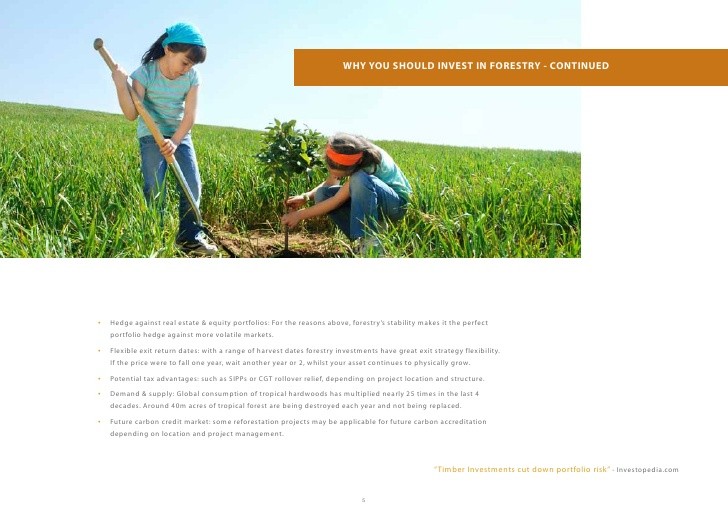Forestry Investments Cut Down Portfolio Risk
Post on: 25 Август, 2015 No Comment

Forestry Investment News and Opinion from John Barnes
Forestry Investments Cut Down Portfolio Risk
As an investor have you ever considered buying trees to enhance your investment portfolio? For the past twenty years forestry investments have been gaining a reputation as a sound alternative to stocks and bonds. They have gained interest from both institutional and retail investors for their diversification and inflation hedging characteristics. The forestry sector is continually evolving, creating new opportunities for investors to allocate capital for both income and appreciation.
As of 2008 the management of the forestry sector has steadily moved from the manufacturers of timber related products to Timber Investment Management Organisations (TIMOs). The advantage of TIMOs is that they have the market knowledge to maximise productivity and increase investor return. They employ experts in forestry management, research analysts and market experts who can design and execute the appropriate investment strategy.
Why forestry?
There will always be a need for timber, either for building materials, paper, furniture, etc and as forest related product development grows the demand for timber increases. To put it in perspective according to the Society of American Foresters every American consumes a 100ft tree each year. This is in despite of paper recycling efforts.
As mentioned before forestry investment is known for being an inflation hedge. Trees increase in value ‘on the stump’ at a rate greater than inflation. In the last century (1905-2005) timber prices have grown at a rate that is approximately 3% greater than inflation.
So if a recession hits as was the case two years ago and the original buyer cannot go ahead with the purchase then the trees can continue to grow and increase in value until a new buyer is found. This of course does depend on what the trees are being grown for. If you have invested in a eucalyptus plantation in Brazil then the chances are that when the trees are cut down they will be turned into charcoal to be used in the Brazilian steel industry. Since a law was passed early this year whereby all steel producers have to use charcoal from eucalyptus plantations it is unlikely that your investment would be affected by a recession.
A forestry investment is also a lot less risky than playing the stock market and the returns can beat them hands down. When measuring returns using the National Council of Real Estate Investment Fiduciaries (NCREIF) Timberland Index, forestry investment returns exceeded those of the S&P 500 from 1990 through 2007. In that period of time, the NCREIF Timberland Index annual compounded return was 12.88% versus 10.54% for the S&P 500 index. This excess in return was also provided with less unpredictability as shown by the Sharpe ratios for the same period (1.06 for timber, versus .45 for the S&P 500), underscoring the risk/return benefits of timber over the overall stock market.
In terms of an investment portfolio the addition of a low correlation forestry asset will increase its diversification, which can only be a good thing. As a point of interest the NCREIF Timberland Index returns from 1990 through 2007 showed moderate to weak correlation against equity and fixed-income indexes and a negative correlation to real estate.
The land required to grow forestry plantations is limited and demand is continuing to grow as population and commercial development increases. While the land needed to grow forestry plantations on it can be leased the majority of forestry investors prefer to purchase the land. Depending on location, some property can be targeted as higher and better use land that can be sold to developers at a premium, providing additional appreciation benefits for timber owners.
The risks involved with forestry investments are fairly minimal. While the collapse of markets due to a recession is a potential risk, forestry plantations act as a natural warehouse. Stock can be stored on the stump and when the financial storm is over it is worth even more than when it began. The only other potential risk I can think of is natural disasters, such as fire or flood. However if an investor is smart they spread their investment around and make sure that there is ample insurance to cover any potential loss.
Timber ETFs are a relatively new, less expensive investment option. In November 2007, Claymore Securities announced the launch of the first U.S.-listed global timber ETF, the Claymore/Clear Global Timber Index ETF (PSE:CUT). CUT tracks the Clear Global Timber Index, which includes companies that own or manage forested land and harvest the timber for use and sale of wood-based products, such as lumber, pulp and paper products. Components must have at least a $300 million market capitalization and the index excludes any companies that do not own or manage forested land. Any component in the index cannot exceed 4.5% of the total index.
But by far and away the best reason for including a forestry investment in your investment portfolio is its ability to enhance risk/return characteristics. As well as being an excellent portfolio diversifier and inflation hedge, forestry makes a great investment due to the fact that its returns are equal to or better than many other asset classes.
For more information on investing in Forestry please click here
This entry was posted on Friday, February 19th, 2010 at 3:50 PM and is filed under Uncategorized. You can follow any responses to this entry through the RSS 2.0 feed. You can leave a response. or trackback from your own site.














